Our Mission
Making Passive House Building Standards the foundation of resilient buildings that fight climate change.
Passive House Certification Standards provide the quality control framework needed to create buildings that are:
• Fundamentally low energy, making Net-Zero and all-electric buildings possible, setting the stage for our carbon free future
• Durable and resilient
• Comfortable and healthy
• Promoting climate justice in historically impacted neighborhoods
• Enabling us to meet the commitments of the Massachusetts Global Warming Solutions Act
PHMASS is a member-based, non-profit organization that focuses on education, training, outreach and advocacy to accomplish it goals.
We regularly host meetings, trainings, tours, and other events related to Passive House design and construction and serve as a hub of knowledge for high-performance design in the state and region.
Our Members
PHMA members include designers, builders, engineers, policy makers, students, community leaders, and all those interested in high-performance, energy efficient buildings. From regular member meetings and educational programming to tours and special events, there are plenty of way for members to become involved and membership support is essential to our work promoting and expanding the use of Passive House and high-performance building.
About Passive House
Buildings like our homes, offices, and schools are responsible for over 40% of energy use and greenhouse gas emissions. Fortunately, there is a better way to design and construct buildings to reduce this impact and contribute to a low-carbon future. Passive House is an building performance standard that delivers a high level of energy savings and carbon reduction for all building types while providing a more healthy and comfortable space to live and work.
A Passive House can be any building - a school, an apartment building, a new residential home or a historical renovation, even an large office skyscraper. Through a thoughtful and integrated design process and a detail oriented approach to construction that prioritizes a well insulated and air-sealed envelope, natural light and solar gain, and highly-efficient HVAC systems, we can create buildings that use over 90% less energy for space conditioning and over 60% less energy overall.
Passive House buildings achieve:
- Drastically lower energy use and operational cost savings
- Healthy air quality from ventilation systems
- Consistent and comfortable room temperatures without air drafts
- Increased natural lighting and quieter acoustic conditions
- A more resilient and comfortable building
On top of all of this, the lower energy demand of Passive House buildings means that the limited energy they do need can be easily provided by solar power, creating a pathway to a net-zero or net-positive building.
